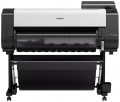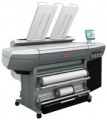Max resolution
The highest image resolution the plotter is capable of printing on paper. It is indicated by the number of dots per inch horizontally and vertically — for example, 1440x720.
The higher the resolution, the smoother the printed image will be as a result, the less noticeable individual dots will be on it (to the point that they cannot be seen at all with the naked eye). On the other hand, the ability to print in such resolutions affects the price of the plotter accordingly. In addition, do not forget that high-quality printing requires appropriate source materials — the quality of the print cannot be higher than the quality of the original image.
Note that in this case we are talking about the maximum resolution; usually in the settings it is possible to set more modest parameters.
Sheet printing time
Approximate time taken by the plotter to print one sheet.
This indicates for the paper size that the machine was originally designed for (see "Paper Size"). And it is approximate because it is usually given for optimal or almost optimal printing conditions: low quality and resolution, relatively simple images, etc. So the actual print time of the sheet may differ from the claimed one in one direction or another, depending on the operating parameters — starting from the mentioned quality and resolution to the type of media. However, according to the figures indicated in the specs, it is quite possible to evaluate different models and compare them with each other: the difference in the claimed time, usually, will proportionally correspond to the difference in the actual printing speed.
It is also worth noting that this time is usually indicated by the duration of the printing process itself — from the capture of the sheet by the feeder to the output of the completed print from the device. Interruptions inevitably occur between printing individual sheets, so that the total printing time is longer than the printing time of a sheet multiplied by the number of sheets. For example, a device with a time consumption of 36 sec per sheet theoretically should print about 100 sheets per hour (1 h = 3600 s, 3600/36 = 100), but in fact such a plotter usually produces about 70 – 75 sheets in this time.
Drop volume
The smallest drop volume of ink that can be produced by the printhead of an inkjet or similar plotter (see "Product Type").
This parameter is directly related to the print resolution (see “Maximum resolution”): the more dots per inch, the smaller the separate dots and, accordingly, the drops should be. At the same time, models with the same dpi number may differ slightly in this parameter. In such cases, it should be assumed that a smaller droplet volume potentially provides better print quality, with more accurate reproduction of fine lines and borders between individual areas of the image, however, such features accordingly affect the price of the device.
Sheet printing
Ability to use the plotter to print on separate sheets of paper. Roll media is widely used in large format printing and some devices may not be able to handle other options. Therefore, the possibility
of sheet printing, usually, is separately indicated in the specs. At the same time, many models allow the use of larger sheets than provided by the supported paper format (see above) — the main thing is that the sheet fits into the device in width.
Media width (min)
The smallest width of paper or other media that the plotter can handle. Such devices, by definition, are designed for large-format printing and are poorly suited for small media; therefore, if you plan to frequently print on sizes smaller than standard (see "Paper Size"), you should pay attention to this parameter and make sure that the selected plotter can work with all the necessary materials.
Media width (max)
The largest width of paper or other media that the plotter can handle. The larger this parameter, the larger the materials that can be printed on the device; however, the dimensions, weight and cost of the plotter also increase markedly due to this.
Max. roll diameter
The largest roll diameter that can be installed in a plotter with roll printing (see above). This parameter is useful primarily for the selection of media: the material of the same width can be produced in rolls of different diameters.
Number of rolls
The number of rolls that can be installed in a plotter that can print from such media at one time (see above).
Most often, such models are made for one carrier, however, there are also more advanced units — for
2 or more rolls(in some cases this number reaches 4). The meaning of this functionality is that you can simultaneously use media of different sizes (for example, A1 and A2) or/and types (for example, glossy and matte paper) while printing. Of course, you can only print on one material at a time; however, the presence of multiple rolls allows you to switch between them simply through the settings of the plotter, without fiddling with changing media.
Paper grammage (min)
The lowest grammage of paper that the plotter can print normally on. Grammage is expressed in grams per square metre; accordingly, the more dense the paper, the thicker it is, and the greater the difference between the minimum and maximum paper grammage, the greater the range of materials the plotter can operate with.
The use of materials that are too thin can lead to a number of troubles: multi-sheet picking, creasing, jamming, etc. Therefore, if you plan to use low-grammage paper, you should pay special attention to this characteristic.

